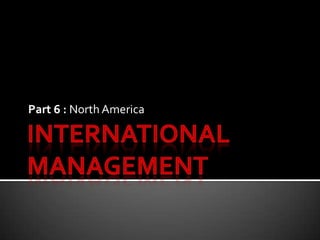
North America's Diverse Cultures, Landscapes, and Economies
- 1. Part 6 : North America
- 3. Presentation by Célia Junon, Thomas Lochot, Giovanni Rasoli and Pierre Urier-Cattoire.
- 4. 1. Geography and Demographics Climate, Povinces and Territory, Population 2. Cultural facts Languages, Religions, Gastronomy, Sports 3. Governement and Economy Politics and Law, Economy, International relationships 4. Doing business in Canada Business structure, Management, Communication
- 6. Population in Canada (2010) : 33 993 106 Main provinces in term of population : • Ontario: 12 890 800. • Québec: 7 744 530. • British Columbia: 4 430 360. • Alberta: 3 512 370.
- 7. The biggest part of the population lives in big cities. Toronto: 12 890 800 inhabitants. Other important cities: Montréal, Vancouver, Calgary. 99% of the Canadian live in big cities, a large part of the territory is not occupied.
- 8. 10 provinces : • Ontario, Québec, British Columbia, Alberta… 3 territories : • Northouest Territories • Yukon • Nunav
- 9. Ontario Represents 41% of Canada’s Gross Domestic Product. Toronto: more than 100 different languages spoken. 250 000 lakes.
- 10. Québec Member of Canada’s Confederation since 1867. Represents 15% of the total Canada’s area. French is the first language.
- 11. British Columbia Attractive place: skiing, fishing, hiking, the best place in the world to see grizzly and other kind of bears. 35 000 immigrants come to live in Toronto each year. Many visitors came last year to visit Vancouver: 22 millions.
- 12. Alberta Main resources: oil and natural gas. Rodeos parties every year. 29 colleges.
- 13. 6 diferent climates : • North • South • Pacific coast • Meadows • Atlantic coast • Great Lakes area
- 14. Sources : http://gomestic.com; www.foodbycountry.com; www.kwintessential.co.uk
- 15. A multitude of languages are spoken in Canada. English and French are recognized by the Constitution of Canada as “official languages”. 85% of French-speaking Canadians live in Quebec. Language Percentage Religion Percentage English 67.1% Christianity 77.1% French 21.5% No religion 16.5% Chinese 2.6% Islam 2.0% Punjabi 0.8% Judaism 1.1% Spanish 0.7% Buddhism 1.0% Italian 0.6% Hinduism 1.0% Arabic 0.5% Sikhism 0.9%
- 16. Family heritage influence. The sporting culture of Canada is different from Maple syrup and maple many other countries. products are popular. • Ice hockey • Football • Basketball • Base-ball
- 17. Gift giving Dining customs
- 18. Sources : www.pch.gc.ca; DataMonitor – Study of Canada
- 19. General facts (2009): Head of State: Elizabeth II Governor General of Canada : Michaëlle Jean Prime Minister: Stephen Harper Growth: -2.5% Unemployment: 8.6% Currency: Canadian Dollar (0.63054€)
- 20. Political landscape: • High government effectiveness and stable direction under both Conservative and Liberal rule Political instability and disparities of development • Conservatives to power in 2006 after 12 years of Liberal rule • Parliament disolved in 2008 Conservatives became a minority (38%) • Collaboration to dislodge Harper’s government • Regional disparity between western and eastern provinces • Government is accused of helping the west and the French-speaking provincies more more than the others (most developped provinces) • Inequitable internal growth
- 21. Economy landscape: • Global slowdown (growth: -1% in 2009), low productivity growth for the past 5 years and financial turbulence with not-evenly spread growth across all provinces and territories Slowdown in the economy • CAGR (Compounded average growth) from 2000 to 2007: +1,9% • CAGR in 2008: -0,65% • Bugetary deficit due to a drain on the state’s finances.
- 22. Decreasing GDP (constant price) in 2009 with a holding up rise of inflation since 2006 Stable commercial balance Decreasing unemployement Growth of communication
- 23. Low business tax rates attract foreign investors • One of the most conducive legal climates for investments. • 7th best investment regime in terms of business freedom (WSJ). • One of the most flexible labor markets in the world. • Lowest payroll taxes among the G8 countries. • But businesses une the country have to bear one of the world’s highest marginal effective tax rates on investment. International environmental targets • Proactive stand on environmental issues since 1990: remains the forefront in meeting the environmental challenges. • But Canada has a poor rating in terms of environmental performance. • Tries very hard to achieve its target under the Kyoto Protocol. Greenhouse gases will decline starting in 2010 (all sources)
- 24. Sources : www.kwintessential.co.uk; http://globalgateway.monster.ca
- 25. Let’s introduce this topic with a video… Agreeable, polite, quiet, reserved and passive- aggressive, are all the words to describe Canadian.
- 26. Business Structure: Many Canadian companies have abandoned traditional hierarchical approaches in favor of more simple and open structures. Canadian Management Strategy: Manager = a part of the company. After having consulted each members of Canadian Meeting: the group, he is in charge of the final decision and so expected to be decisive. Democratic meetings: people expect the right to be heard and listened to Interpersonal and man-management skills regardless of rank or status. are considered of vital importance. Canadian are essentially rational and logical.
- 27. Canadian Team: Canadian Communication Style: People of the team expect to be valued for their contribution. Conflict is a dirty word in Canada. Cultural diversity is recognized and respected. There is a “moderately indirect” communication. Women in business : Absolutely integrated into the Canada business environment.
- 28. CONCLUSION People do not have authority just because of their name, status, social class or sex. Canadian business people are conservative in manner, speech and the way they dress. Let’s conclude this topic with a video …
